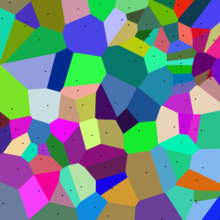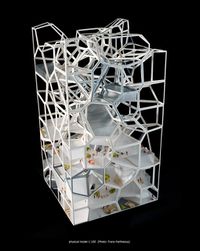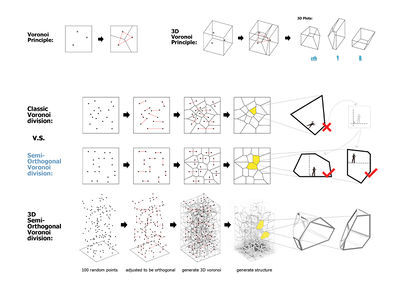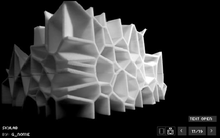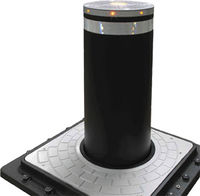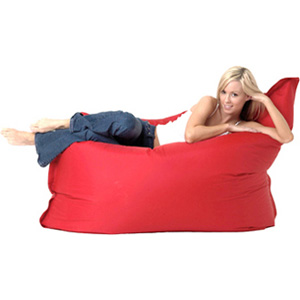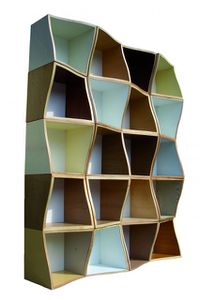atom07:References
(→Readings) |
|||
| Line 203: | Line 203: | ||
| + | Folding materials by robotic arms | ||
| + | |||
| + | http://www.robofold.com/ | ||
| + | |||
| + | |||
| + | Connecting the digital to the real world | ||
| + | |||
| + | http://vimeo.com/14637158 | ||
| + | |||
| + | |||
| + | direct digital manufacturing | ||
| + | |||
| + | http://en.wikipedia.org/wiki/Direct_digital_manufacturing | ||
Revision as of 15:38, 3 October 2011
different groups of references
Contents |
A Possible Way of Form Finding
The basic logic of voronoi diagramming algotithm is as follow. We are given a set of points S in the plane, which are the Voronoi sites. Each site s has a Voronoi cell, V(s) consisting of all points closer to s than to any other site. The segments of the Voronoi diagram are all the points in the plane that are equidistant to the two nearest sites. The Voronoi nodes are the points equidistant to three (or more) sites.
There are several advantages by using this algorithm:
1. Creating a dynamic network consisting of non-uniformed, continuous, potentially evolutionary units rather than grid and the assembly of pre-defined components.
2.The outputs will take on the adaptablility to the changeable context and client data-sets
3.Articulating a variety of spaces, functions, scales and social behaviors
Reference 1:Vertical Village
This design is based on the application of Voronoi Algorithm in three dimensional.
Reference 2:G_Nome
This design applies Voronoi Algorithm
different groups of references
Shape shifting
Multiple elements
Inteligent elements
http://www.ted.com/talks/skylar_tibbits_can_we_make_things_that_make_themselves.html In the lecture above Skylar Tibbits talks about homogeen elements which are able to addept in shape size and possible are able to change function in this way.
Changing shape due to current
ShapeShift is an experiment in future possibilities of architectural materialization. This project explores the potential application of electro-active polymer (EAP) at an architectural scale. EAP offers a new relationship to built space through its unique combination of qualities. It is an ultra-lightweight, flexible material with the ability to change shape without the need for mechanical actuators. As a collaboration between the chair for Computer Aided Architectural Design (ETHZ) and the Swiss Federal Laboratories for Materials Science and Technology (EMPA), ShapeShift bridges gaps between advanced techniques in architectural design/fabrication and material science as well as pushing academic research towards real world applications.
Changing shape due to pneumatics/hydrolics
A project of the Hyperbody studio at faculty of architecture in 2004. Here they made a tower which is able to move controlled i different manners.
Single element
Hoberman sphere
This Hoberman sphere is able to change scale and still keep the same shape.
Poller
This pollar is a good example of a changeable element, when the poller is needed the element is up and when a car needs to cross (with approval) then the pollar will go down. The movement of the shape is purely functional.
Origami
Changeable shape don't need to consist very complex technical elements motors or connections, by making the right connections a lot of changes are already possible. Good examples of this are different origami creations.
Interactive architecture
Interactive architecture is hard to distinguise from art. Often the interactive part of building isn't the essence of a building but rather a addition to it. This is addition is nice and sometimes functional as well, however we feel that in a lot of cases this feature will loose it's wow factor. some examples
This facade detects objects in front it, by changing the translucense of the small element it reacts in real time on it'senvironment. This facade does a trick, after people experienced it they will quit quickly get bored with it, this is something we want to prevent. In future intervention the activity will be for functional reasons.
Adaptive to user
A beenbag, what is more simpeler and lowtecht example of a multi element (beans) object adepting in shape and size to accomodate the user. The same goes for faom matrasses, according to the weight putt on these matrasses the shape changes to addept to the human body.
Changing function
here can be references which change shape to accompany different functions but also references which only change ambiance to hold different functions.
Readings
Christopher Alexander, Pattern Language
http://en.wikipedia.org/wiki/Pattern_language
Tchumi vs. OMA
http://architecturalassociation.ie/pdf/BM_13.pdf#page=53
Urban Landscapes
http://www.rali.boku.ac.at/fileadmin/_/H85/H852/X_LArch_3_2009_090531_xlarch_all.pdf#page=132
Folding materials by robotic arms
Connecting the digital to the real world
direct digital manufacturing
http://en.wikipedia.org/wiki/Direct_digital_manufacturing
